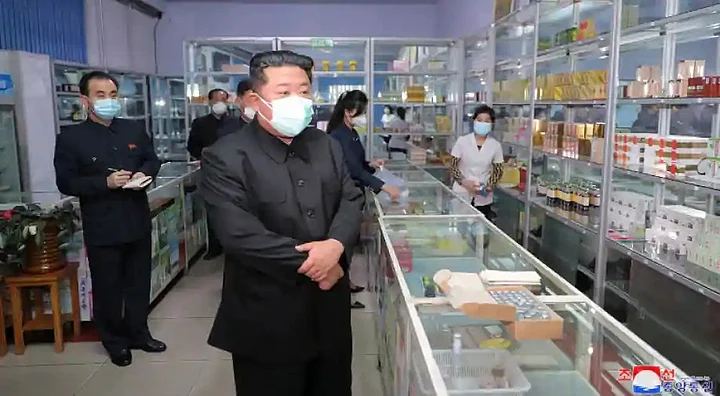The World Health Organization (WHO) declared COVID-19 a pandemic in March 2020. But it’s only in recent days, in May 2022, that the secretive Democratic People’s Republic of Korea (North Korea) has reported its first confirmed cases of the virus.
While it may seem somewhat astounding that a country has managed to get so far into the pandemic without an outbreak, North Korea has reportedly had its borders sealed since January 2020, with no movement in or out of the country. So it is plausible that they’ve had no COVID-19 until now.
But now, the country, which has a population of roughly 26 million people, looks to be facing a very sizeable and rapidly-spreading outbreak of the omicron variant. As of 17 May, 1.4 million cases of “fever” had been reported, with 56 deaths since late April. The country is treating fever as indicative of COVID-19 infection owing to reported shortages of testing supplies.
Of course, we don’t know how many of these cases of fever are definitely COVID-19, which in theory could lead to an overestimation of case numbers. At the same time, a proportion of cases are likely to be asymptomatic, and a lack of reporting coupled with limited surveillance means there’s a likelihood of under-reporting. Either way, these numbers are unlikely to be accurate.
There has been some testing taking place, with an unspecified number of omicron cases confirmed. But ultimately, there are huge gaps in our knowledge about this outbreak. This includes the index case – the case which was the source of this outbreak.
North Korea Is Ill-Equipped for a COVID-19 Outbreak
The COVID-19 pandemic has highlighted the need for national and global presentations of high-quality real-time data, along with rigorous and mass-scale testing infrastructure, to underpin surveillance and healthcare decision-making. North Korea doesn’t appear to have any of that in place.
Importantly, there’s also no known COVID-19 vaccination programme in North Korea, despite previous offers of supplies from China and COVAX, a global initiative which aims to provide equitable access to COVID-19 vaccines. The government has previously turned down three million Sinovac doses from China, along with shipments of the AstraZeneca vaccine, the latter reportedly due to concerns around side effects. Now, South Korea has offered to donate vaccine doses, but North Korea is yet to accept.
To some extent, North Korea is in the same position the rest of the world was in early to mid 2020. The government has ordered a national lockdown.
This will have socio-economic consequences for residents but, overall, is probably a sensible move, given the population will have little immunity against the virus, whether through prior infection or the safer route of vaccination.
Kim Jong-un has also ordered the army to distribute medicines and supplies, while criticising officials and the public health sector for what he has deemed an inadequate pandemic response.
The healthcare system in North Korea is reported to be fragile, especially away from the capital city of Pyongyang. An outbreak could easily overwhelm the health facilities in some areas. This would have a knock-on effect to other areas of healthcare, further limiting access to care for non-communicable diseases, for example. A lockdown will at least buy the country some time to implement other public health measures, such as vaccination campaigns.
It is thought that North Korea has a lower prevalence of some of the conditions which we know increase the risk of severe COVID-19, such as obesity, compared with many other Asia and Pacific countries.
However, more than ten million people in North Korea are considered to be food insecure (where having access to sufficient safe and nutritious food isn’t guaranteed). And we know malnutrition increases the risk of severe disease with COVID-19.
Another factor which increases risk is older age. An estimated 10 percent of the population in North Korea is aged 65 or over, and roughly another 19 percent aged between 50 and 64. So there are a large number of people who may be vulnerable to severe illness if they contract COVID-19.
How Will Things Play Out?
New variants of concern may emerge from this outbreak, though given the lack of contact with the rest of the world, they may not be easily exported.
There have been several humanitarian catastrophes related to uncontrolled COVID-19 outbreaks, perhaps most notably in India, where it’s likely that hundreds of thousands, if not millions, died in just a few months. With uncontrolled outbreaks on such a large scale, the true death tolls can only ever be estimated.
The situation in North Korea threatens a similar humanitarian catastrophe. We know infection numbers can get very large very quickly, particularly with omicron being even more infectious that previous variants.
Routine datasets, such as death registers and certificates indicating cause of death, are likely to be limited and of low quality. Public reporting may be non-existent, and if surveillance data is revealed, the accuracy of the findings should be given very careful consideration.
This COVID-19 outbreak is likely to create a high burden of disease in North Korea, putting huge pressures on the health system. The population will undoubtedly suffer greatly, whether or not public reporting of health outcomes shows the full fallout.
There is an urgent need for widespread COVID-19 vaccination, particularly of older and vulnerable people. Now would be a very good time for North Korea to overcome its usual suspicion of the outside world, and accept international offers of help.
(Michael Head is a Senior Research Fellow in Global Health at the University of Southampton. This article was originally published on The Conversation. Read the original article here.)
(At The Quint, we question everything. Play an active role in shaping our journalism by becoming a member today.)
